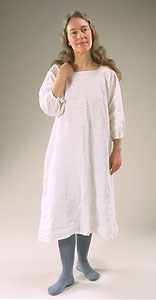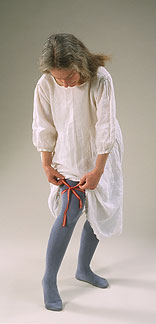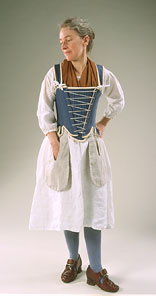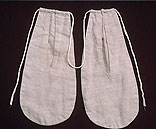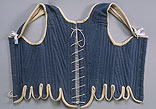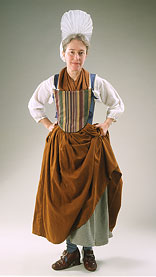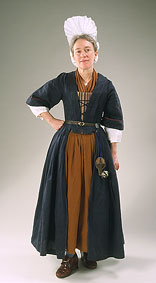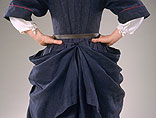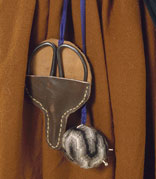




Advanced Search
Dress Up | 1st Person | African American Map | Now Read This | Magic Lens | In the Round | Tool Videos | Architecture | e-Postcards | Chronologies Turns Activities
Women's Clothing from 1700Many women in the early 1700's did not own more than about 2-4 outfits. Their clothing would usually be made of wool or linen and would all be hand sewn. The styles of the times dictated that elbows and knees be covered at all times! Standards of cleanliness were very different from today as germs had not been discovered yet and the links between dirt, infection and disease had not been made. This meant that clothing was not washed often and some items that did not touch the skin, such as a gown, might never be washed! Go to interactive Flash version Undergarments
ShiftA shift would be made of linen and would serve as both nightgown and slip. A woman might only own two or three. She would wear her shift night and day, often for weeks or more at a time especially in winter, without laundering. Underpants did not exist yet so a woman would wear absolutely nothing under her shift!
StockingsEveryone wore socks called "stockings" that came up over the knee. They were commonly hand-knitted of wool or linen. Elastic had not been invented yet, so stockings were held up with garters. These garters could be made of ribbon, knitted or leather strips and might tie or buckle on above or below the knee. This woman wears garters made of cloth tape, that tie on. Foundation Garments
HairPeople did not wash their hair as often as we do today. One might not wash their hair all winter long! This is one reason why a woman wore her hair up in a bun and away from her face. KerchiefFor modesty sake, a woman wore a kerchief of silk, linen or cotton. Only for a formal occasion such as a party or ball would she not wear one. ShoesA common woman would have one or two pairs of shoes. They were hand sewn by "cordwainers", or shoemakers, and had no rights or lefts.
PocketsWomen's clothing did not have attached pockets. A pocket or two would be tied on around a woman's waist before she put on her final layer. Gowns and petticoats had slits in the sides for access to pockets. Pockets were not meant to show, as they contained personal and sometimes valuable items.
StaysStays are a support garment stiffened with whalebone, wood or reed; that provides good posture and the ice cream cone-shaped silhouette that was popular throughout most of the 18th century. A woman might start wearing stays as a toddler! If she did not have the skill to make her own, she could purchase stays that had been imported from England. However, there was no guarantee that they would fit! The woman shown here made an extra piece to slip under the front lacing to provide a better fit. Daily Garments
PetticoatsThis woman wears two petticoats. Today we call them skirts. A woman would wear up to four of five petticoats, depending upon the weather. StomacherGowns and jackets in the early 18th century had gaps in the front. A stomacher was a decorative piece, often of nice fabric, that a woman would pin to the front of her stays to hide them and make her outfit a little fancier. CapIt was both practical and stylish for a woman to wear a cap. It covered dirty, possibly lice-infested hair and kept it away from the fire. A woman would wear a cap both indoors and out. When outside she might put on another hat over her cap. A "frontage" was one of several styles popular in the late 17th and early 18th centuries.
GownThis style of gown is known as a "mantua". It was very popular from the late 17th century through the first half of the 18th century. It laces up the front. It was worn with the skirts hanging down or hooked up in the back. BeltBelts were optional for women's clothing. They were made of leather with brass or silver buckles.
Pin Ball & Scissor ClipSome women kept their sewing equipment handy by using a scissors clip that hooked onto a belt or apron strings. Any number of items could be attached to it by chain or ribbon. This woman has scissors and a ball for holding pins and needles. Outer Garments
CapeWomen did not wear coats in winter. They wore woolen capes that could be short, as shown here, or long. HoodIf a cape did not have an attached hood, a woman would have a separate one. She would wear it over her cap. MittensMittens were homemade from wool yarn spun and knitted by a female family member. BasketBaskets served many functions. This one is being used as a purse. See Also...
|
| |
Home | Online
Collection | Things
To Do | Turns Exhibit | Classroom | Chronologies My
Collection
About This Site | Site
Index | Site Search | Feedback
